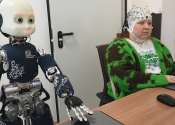How to train your robot (to feed you dinner)
About 1 million adults in the United States need someone to help them eat, according to census data from 2010. It's a time-consuming and often awkward task, one largely done out of necessity rather than choice.
Mar 11, 2019
2
23









